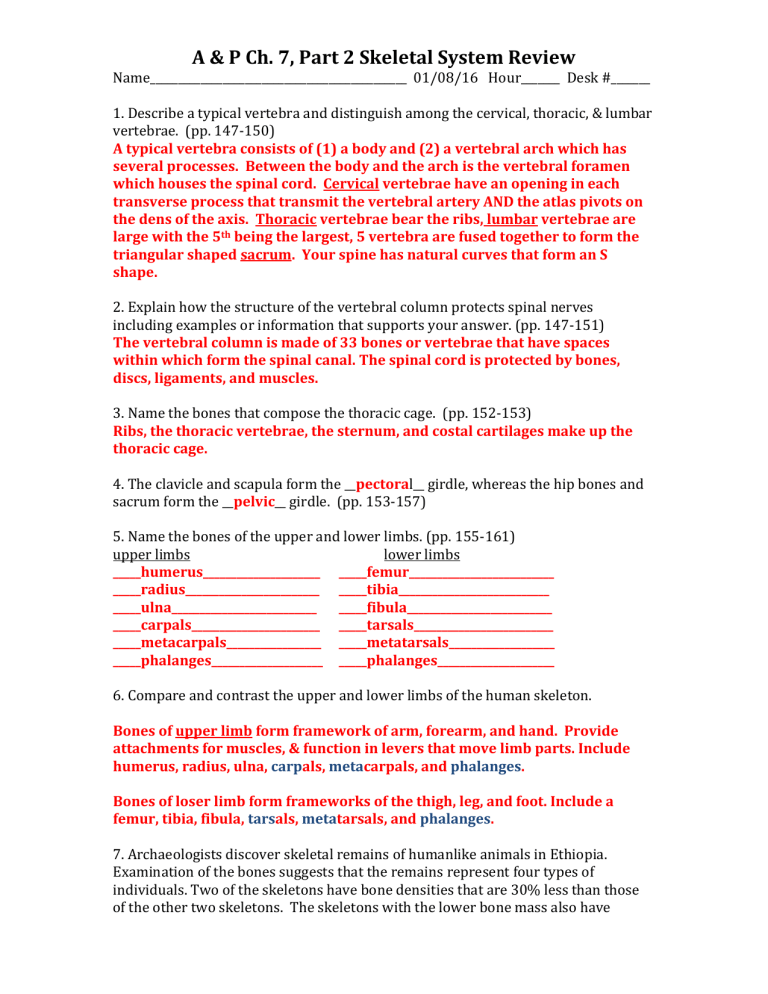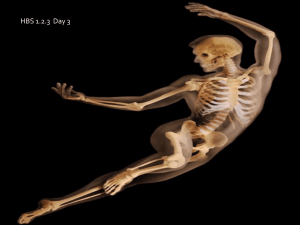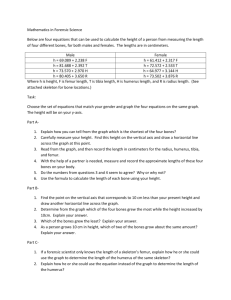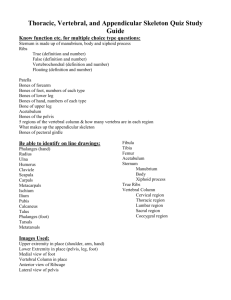
A & P Ch. 7, Part 2 Skeletal System Review Name______________________________________________ 01/08/16 Hour_______ Desk #_______ 1. Describe a typical vertebra and distinguish among the cervical, thoracic, & lumbar vertebrae. (pp. 147-150) A typical vertebra consists of (1) a body and (2) a vertebral arch which has several processes. Between the body and the arch is the vertebral foramen which houses the spinal cord. Cervical vertebrae have an opening in each transverse process that transmit the vertebral artery AND the atlas pivots on the dens of the axis. Thoracic vertebrae bear the ribs, lumbar vertebrae are large with the 5th being the largest, 5 vertebra are fused together to form the triangular shaped sacrum. Your spine has natural curves that form an S shape. 2. Explain how the structure of the vertebral column protects spinal nerves including examples or information that supports your answer. (pp. 147-151) The vertebral column is made of 33 bones or vertebrae that have spaces within which form the spinal canal. The spinal cord is protected by bones, discs, ligaments, and muscles. 3. Name the bones that compose the thoracic cage. (pp. 152-153) Ribs, the thoracic vertebrae, the sternum, and costal cartilages make up the thoracic cage. 4. The clavicle and scapula form the __pectoral__ girdle, whereas the hip bones and sacrum form the __pelvic__ girdle. (pp. 153-157) 5. Name the bones of the upper and lower limbs. (pp. 155-161) upper limbs lower limbs _____humerus_____________________ _____femur__________________________ _____radius________________________ _____tibia___________________________ _____ulna__________________________ _____fibula__________________________ _____carpals_______________________ _____tarsals_________________________ _____metacarpals_________________ _____metatarsals___________________ _____phalanges____________________ _____phalanges_____________________ 6. Compare and contrast the upper and lower limbs of the human skeleton. Bones of upper limb form framework of arm, forearm, and hand. Provide attachments for muscles, & function in levers that move limb parts. Include humerus, radius, ulna, carpals, metacarpals, and phalanges. Bones of loser limb form frameworks of the thigh, leg, and foot. Include a femur, tibia, fibula, tarsals, metatarsals, and phalanges. 7. Archaeologists discover skeletal remains of humanlike animals in Ethiopia. Examination of the bones suggests that the remains represent four types of individuals. Two of the skeletons have bone densities that are 30% less than those of the other two skeletons. The skeletons with the lower bone mass also have broader front pelvic bones. Within the two groups defined by bone mass, smaller skeletons have bones with evidence of epiphyseal plates, but larger bones have only a thin line where the epiphyseal plates should be. Based on the information provided about the archaeological find and found in the textbook, give the age group and gender of the individuals in this find. Justify your answer. Based on information given above and what is found in textbook, the larger more dense bones in which epiphyseal plate has closed are males who have finished growing. The smaller skeletons with lower bone densities, broader pelvic bones, and evidence of epiphyseal plates are young females that have not finished growing. 8. Name the bones of the upper and lower limbs that articulate/form joints. upper limbs lower limbs Examples: Examples: glenohumeral joint=scapula & humerus hip joint=hip and femur sternoclavicular joint=clavicle & sternum patellofemoral joint=patella & femur humeroulnar joint=humerus & ulnar tibiofemoral joint=tibia & femur radiohumeral joint=radius & humerus interphalangeal joints=distal, middle & proximal phalanges #9 Match the terms below to the parts indicated on the diagrams. __C___body __E___cervical curvature ___I__coccyx/coccygeal __G___lumbar curvature __H___sacral/sacrum ___A__spinous process __B___transverse process ___F__thoracic curvature ___D__vertebral foramen/intervertebral forimina





